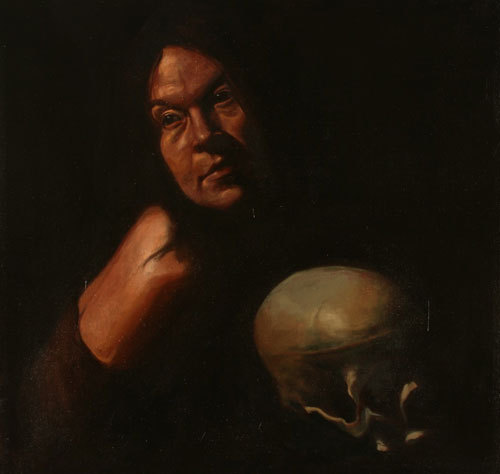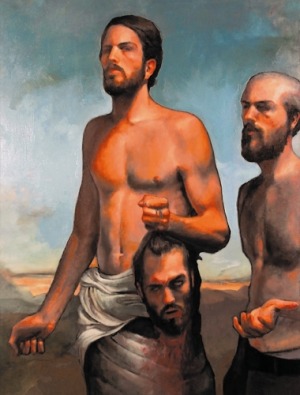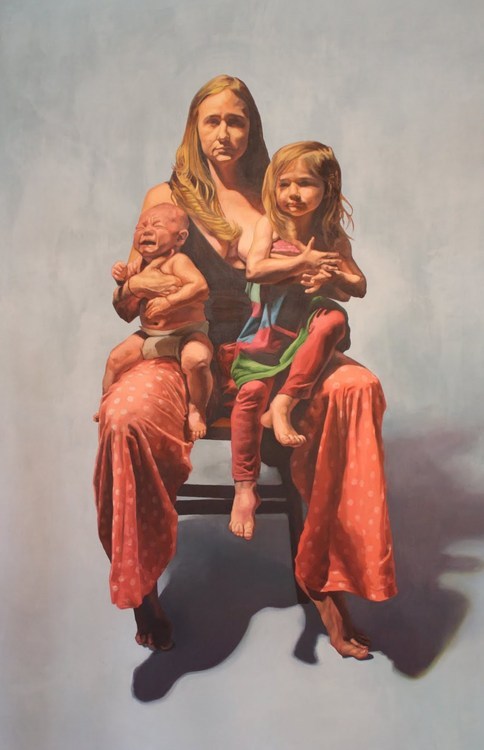Scott Avett is well-accustomed to crowds. He and the rest of The Avett Brothers have been performing for arenas full of fans for years now. And Scott is used to baring his soul; his songs are personal and hold no punches.
It was a more intimate crowd — about 300 people — who had the opportunity to see and hear Avett on Nov. 22, 2010. But he was not performing for this fortunate few. He was speaking to them about faith, his visual art, and about his search for truth.
In 2010, I was serving as Executive Director of Center for Faith & the Arts in Salisbury, NC, a unique organization that seeks to give the public opportunities for spiritual enlightenment through arts encounters. One of its activities had been a yearly colloquy with an artist as guest speaker.
I had only been heading CFA for a few months when I suggested inviting Scott Avett to be the colloquy speaker. I was trying to widen the organization’s appeal. Up until then, the Center’s events seemed to be drawing a rather small number of older, erudite participants. I was looking for a speaker who would bring in a younger audience previously unacquainted with the organization.
The Avetts had a heavy touring schedule, and I didn’t really believe Scott would have time for what I was proposing. But I am from the “it doesn’t hurt to ask” school of life, and in this case it worked. Not only did he accept the invitation to speak, he also allowed us to display an exhibit of his paintings.
The reason he had been my first choice for this event arose from opportunities I had to interview him in both 2008 and 2010 while I was working as a writer for Salisbury Post. Both conversations were mostly about his paintings, but in the second interview he told me he had recently been reading sermons by his late grandfather, Clegg Avett, a Methodist minister, and also writings of Leo Tolstoy, including What is Art? Although this conversation had begun as just a newspaper interview, it had turned into a lengthy philosophical discussion which impressed me greatly.
One of my favorite things about being Director of CFA was that I also got be be editor of the organization’s magazine, Muse & Spirit. For our Fall 2010 edition, Scott Avett penned the essay “My Search for Truth.” This essay was the centerpiece of that edition, along with photos of Scott and his artwork. Many of those who attended the colloquy event came with their copy of Muse & Spirit in hand to be autographed. Others who heard about the event after it occurred called or wrote to CFA to request copies of the magazine which was the most popular issue to date.
Julianne in Vain, oil on canvas, by Scott Avett
I left my part-time position with CFA in 2011 in order to take a full-time teaching job, but until recently, the online edition of that issue and other past issues of Muse & Spirit were still available. Unfortunately, the links to these past issues have now disappeared with a revamping of the organization’s website.
Rather than allow Scott Avett’s words to vanish into a cyberspace mist, I am reprinting his essay here. I hope more people will have the opportunity to read and contemplate these statements.
This essay is being reprinted with permission of author Scott Avett; he also granted permission to include images of his paintings.
My Search for Truth
by Scott Avett
When I was an art student, a professor told me, “If you are thinking about where a painting is going to hang in a gallery and what others will say and think of it before you have put the first brush to the canvas, you are missing the point entirely.”
Unfortunately, I think many young artists believe (or act as though they believe) an artwork’s final destination is part of its reason to exist, and that is intertwined with the motivation to create the work. And it is probable that this ill motivation is present in all forms of artistic expression. This comes into play when I think of “truth” or genuine delivery in artistic expression.
I have struggled in the studio with this distraction, but I feel confident that no work of mine that has been shown was produced with these poor intentions. And I believe this fact comes across to everyone who views my work, not just those with “art” educations. After all, the relationship between a viewer and a painting, or an audience and a performance, is a very simple and primitive engagement that has always existed and always will.
I do believe that the pollution of “creation with intent to succeed” (either financially or for reasons of notoriety) has never been more apparent than it is in the pop music of our time. Mainstream radio acts more as a pyramid scheme than an outlet for melodies and stories, ie: entertainment. This is terrifying.
A song is written. It is uncomplicated, shallow and thoughtless and flashy with spicy rhythm, a simple melody that is easy to repeat, with tons of fun sounds. It’s ear candy.
A long list of people will invest in the song, feeling sure it will be playing on many stations many times, then advertisers and TV and movie folk pitch in, and soon you have a dollar-generating product trickling down and feeding these investors. The pyramid is in operation, and nothing much is really good about it, except maybe some memorable drives and summers with your teenage daughter’s favorite song repeating over and over and over, and finally you kind of admit the song is not all that bad because you associate it with this special moment you had with your family.
In the end, it is still as far from art as you can go, and no one is better for it.
In all types of art there is a choice. Create what you feel because you believe in it, or create what you think will be “successful,” looked-at or listened to. The difference between the two is this: with the latter, that which will be “successful” can only “succeed” for a temporary moment with you and your physical state, which is certainly temporary, and so is as worthless as the dirt that your body will decay into when it is underground. But that which is created in sincerity, that which reveals part of your soul without control and plan, WILL outlive all of us and be generated between men for years to come. And although the work may not succeed in number of viewers or audience, it still bears a life.
This being said, care and thought in what a creator creates is a plus. But I do not believe that because you feel something you will, without a doubt, go out and make a masterpiece. It doesn’t mean that.
I do believe you won’t produce a masterpiece without truth. This truth is a precious thing, a heart, a nucleus, a child that must be protected from the many distractions and trials that attempt to affect it. So much so that it even must be put away and neglected when necessary.
I don’t know why I go into the studio sometimes. I haven’t shown my art in years, at least not a proper show, but I believe that’s a good thing. I have only worked alone and with my own struggles and truths, and when I bring these works out I do feel quite revealed, exposed, which is something I find harder to feel than I used to. I don’t know why I go into the studio sometimes, but I go when nothing “real” is happening. And though I might leave the studio without accomplishing all that I’d hoped, I am allowing the truth to dictate my day. I would do better to help a neighbor than spend my day chasing a work that is in vain.
Spiritually, I believe that love is the truth that is God that is the common denominator among us all. And I can view my life as I view my work ethic in art. Truth is not about success, and genres have no more useful purpose than to allow newspaper writers to identify what they are writing about. Genres in music, denominations in Christianity, religious faiths among the world, none are more right than the next and the teams that we compile in order to live “successful” spiritual lives are not working. Your faith, and all you need to feel happiness and security and love, lies within you. From there we find the heart that pumps the blood that drives the body to love, to be kind, to share and sacrifice. Art, painting, songs, movement — these are simply extensions of this and a “voice” for this spirit to speak.
I can’t say I am an “artist” because I believe no one knows what that means anymore. There is no one definition because people won’t accept one. Does this mean everything and anything someone says is art is, in fact, art? This is beyond anyone to reason with and the truth is that without spirituality attached, art alone is not worth the trouble it would take to intellectualize this theory as it would, without a doubt, be maddening to most all in search of the definition.
I have always had something to say or show. Most of it, if not all of it, has been only my flawed attempts to represent truth. But it’s been a story that has unfolded over the course of my life.
I often can’t put a finger on what drives me to create. What force drags me to the studio at 6 a.m.? What pulls me out of bed in the middle of the night to jot down a story idea or melody? I just follow it, as it keeps me busy and well-worked.
Those who are proud of what they create, and who help others through it, should count themselves lucky, for this is the seed that grows the vine that traces the path that takes each of us on a spiritual journey with no end or resting place, a journey that can only be guided by the light of faith and can only lead to the flood of light at the final interruption of our life’s journey.
Our hands and minds, legs and mouths, eyes and ears, arms and feet were all made with purpose, and though you may never find that exact purpose, it is your obligation to yourself and God to search for it, and to search endlessly for a perfection that, though you will never achieve it, you MUST seek. This is faith. This is spirituality.
The Fighter II, oil on canvas by Scott Avett
My purpose—my craft—gleamed when I was a child. I was offered hints as to what I might shine in. I was around some people who reiterated this. I squandered much of it as a young man. But not all, and my youth was certainly a practice ground for who I would be later. Now I practice being this person I want to be as often as I can.
It is tempting to try to sound intellectual and complex. These complexities are lies. The truth is simple, and knowledge, although exciting and enjoyable, can destroy a good life.
It’s odd that so many people say they don’t understand Rothko or Pollock when the truth is as simple as a color field or the shape of a paint splatter. In some ways, these are the most conservative and truthful expressions of art that have ever existed.
So with art and spirituality, I see parallels. Both are misread, both are distorted, both are exploited for money, both are misunderstood and misused. As I struggle to find my place in art and in spirituality, I am beginning to believe both are destroyed—not by the lack of understanding that seems to swarm around them, not by the non-churchgoer or the folk artist making unsaleable, offensive work with horrific scenes and poor composition, but destroyed by the millions of people who claim or subtly believe they are right and others are wrong, by the sale of an unfinished Renoir for $13 million because a piece has prestige but not quality or truth.
What I’m trying to say is that neither art nor spirituality is ever “figured out,” and they exist as a journey through each of our lives in different ways and in different degrees. Many believe that they are right, but they are wrong, there is no right. They can’t know the answer. They can only have faith and try.
The Underdog, oil on canvas, by Scott Avett
A creator of art can never stop developing and changing, nor can a spiritual man. In one of my grandfather’s sermons, he compared faith to a ship’s rudder being too tight or too loose, saying we must flex and adapt through life in a spiritual way.
Art is but an extension of spirituality, an expression of this journey through life that dips and climbs and challenges us all. Our faith carries us to the studio to do our work and our faith keeps us searching for perfection.
A life only exists in the moment of now. It has no need to exist in the past, which is over, or the future, which does not exist. Your life is like a blank canvas or a lump of clay. It can remain that way through luxury and idleness. Or it can be shaped through goodness and change, until you arrive at the masterpiece that is your life.
Motherhood, oil on canvas, by Scott Avett
Untitled, 2010
Scott Avett says the above painting was inspired by writings of Leo Tolstoy: The Kingdom of God Is Within You and What I Believe: “Tolstoy tells of acquaintances he has who decide that life is all about enjoyment and comfort and that the honey of life is for tasting, then you die. He illustrates by saying it’s like a person hanging off a cliff, holding on to a bush that is dripping with honey while a black mouse and a white mouse (symbols of day and night which equal passing time) are chewing away at its stem so that it will soon break. Underneath is a pit of fire and nothingness for he who believes nothing.”









